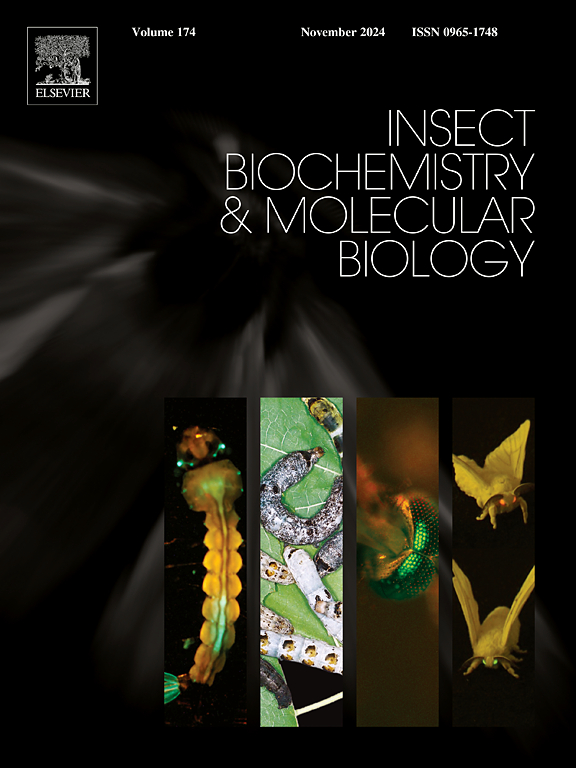Unveiling the functional contribution of GSTe16 to pyrethroid detoxification in Spodoptera litura
IF 3.7
2区 农林科学
Q2 BIOCHEMISTRY & MOLECULAR BIOLOGY
引用次数: 0
Abstract
Glutathione S-transferases (GSTs) play pivotal roles in insect metabolic adaptation to xenobiotic challenges; however, the mechanistic basis of GST-mediated insecticide detoxification, particularly the interaction between GSTs and pyrethroids remains poorly characterized. This study demonstrates that exposure to three pyrethroids (β-cypermethrin, λ-cyhalothrin, and fenvalerate) induces significant elevation in GST activity in the tobacco cutworm Spodoptera litura. The synergistic effects of the GST-specific inhibitor diethyl maleate dramatically potentiated pyrethroid toxicity, indicating a critical role of GST-mediated detoxification. Transcriptional profiling revealed selective induction of GSTe11 and GSTe16 under pyrethroid challenge, with RNA interference-mediated GSTe16 knockdown substantially increasing larval susceptibility. In vivo validation through CRISPR/Cas9 mutagenesis and transgenic Drosophila melanogaster models established GSTe16 as a critical determinant of pyrethroid detoxification. In vitro analyses uncovered the bifunctional capacity of GSTe16: direct metabolic processing of pyrethroids via conjugation and secondary antioxidant defense through reactive oxygen species neutralization. Molecular docking and site-directed mutagenesis identified Arg111 and Asn122 as substrate-specificity determinants in the binding and catalytic subsites, with catalytic mutants retaining full antioxidant activity. This functional specialization reflects evolutionary adaptation of GST architecture, coordinating xenobiotic metabolism with oxidative stress responses. Collectively, these results establish an evolutionary-driven functional compartmentalization within GST architecture, proposing a dual-defense model that synergizes pyrethroid metabolism with oxidative stress resilience.

揭示GSTe16对斜纹夜蛾拟除虫菊酯类解毒的功能贡献
谷胱甘肽s -转移酶(GSTs)在昆虫代谢适应外来生物挑战中发挥关键作用然而,gst介导的杀虫剂解毒的机制基础,特别是gst与拟除虫菊酯之间的相互作用仍然缺乏表征。本研究表明,暴露于三种拟除虫菊酯(β-氯氰菊酯、λ-氯氰菊酯和氰戊菊酯)可显著提高斜纹夜蛾的GST活性。gst特异性抑制剂马来酸二乙酯的协同作用显著增强了拟除虫菊酯的毒性,表明gst介导的解毒作用至关重要。转录谱分析显示,GSTe11和GSTe16在拟除虫菊酯攻击下选择性诱导,RNA干扰介导的GSTe16敲低显著增加了幼虫的易感性。通过CRISPR/Cas9诱变和转基因黑腹果蝇模型的体内验证,证实GSTe16是拟除虫菊酯解毒的关键决定因素。体外分析揭示了GSTe16的双重功能:通过偶联对拟除虫菊酯的直接代谢处理和通过活性氧中和的二次抗氧化防御。分子对接和定点诱变发现Arg111和Asn122是结合和催化亚位的底物特异性决定因素,催化突变体保留了充分的抗氧化活性。这种功能专门化反映了GST结构的进化适应,协调异种代谢和氧化应激反应。总的来说,这些结果在GST结构中建立了一个进化驱动的功能分区,提出了一个双重防御模型,可以协同拟除虫菊酯代谢和氧化应激恢复能力。
本文章由计算机程序翻译,如有差异,请以英文原文为准。
求助全文
约1分钟内获得全文
求助全文
来源期刊
CiteScore
7.40
自引率
5.30%
发文量
105
审稿时长
40 days
期刊介绍:
This international journal publishes original contributions and mini-reviews in the fields of insect biochemistry and insect molecular biology. Main areas of interest are neurochemistry, hormone and pheromone biochemistry, enzymes and metabolism, hormone action and gene regulation, gene characterization and structure, pharmacology, immunology and cell and tissue culture. Papers on the biochemistry and molecular biology of other groups of arthropods are published if of general interest to the readership. Technique papers will be considered for publication if they significantly advance the field of insect biochemistry and molecular biology in the opinion of the Editors and Editorial Board.

 求助内容:
求助内容: 应助结果提醒方式:
应助结果提醒方式:


